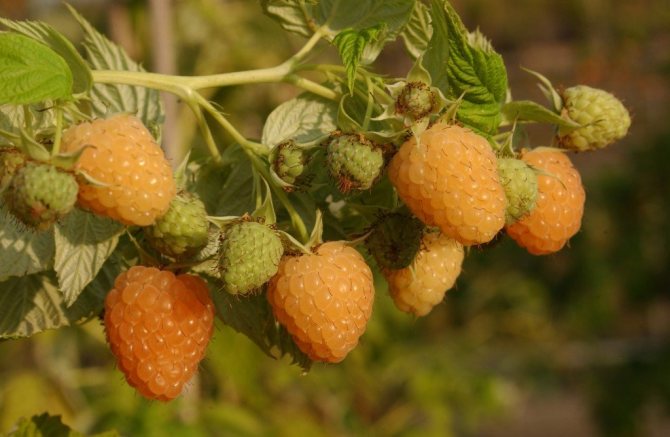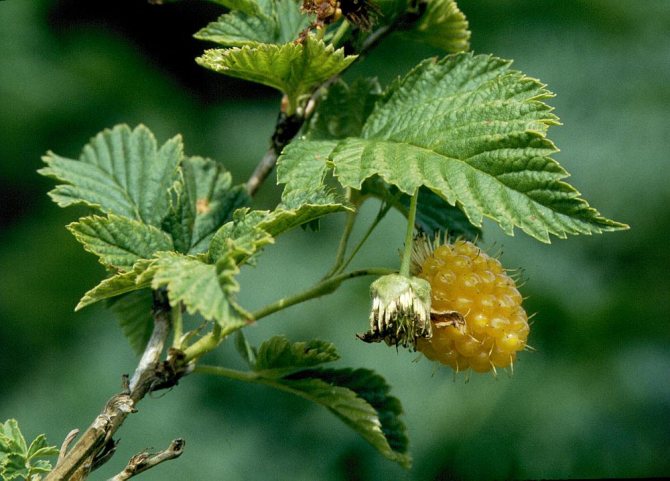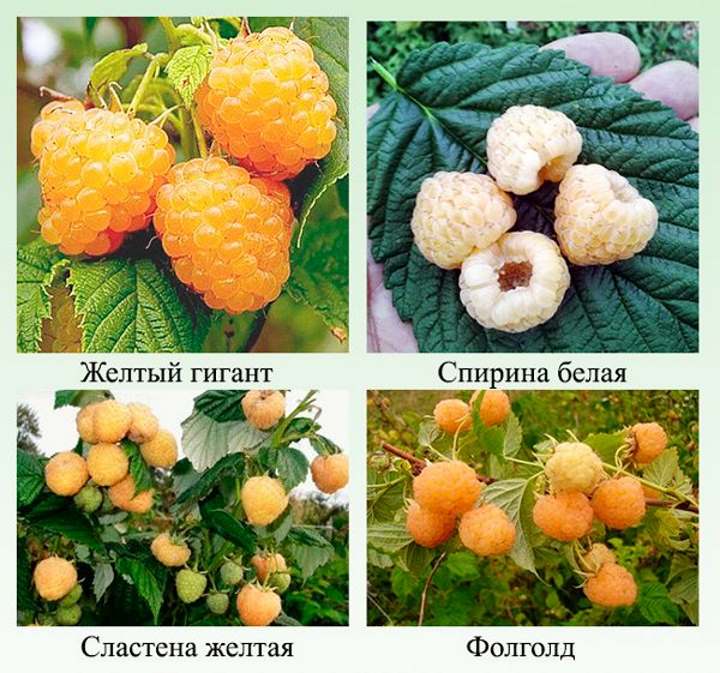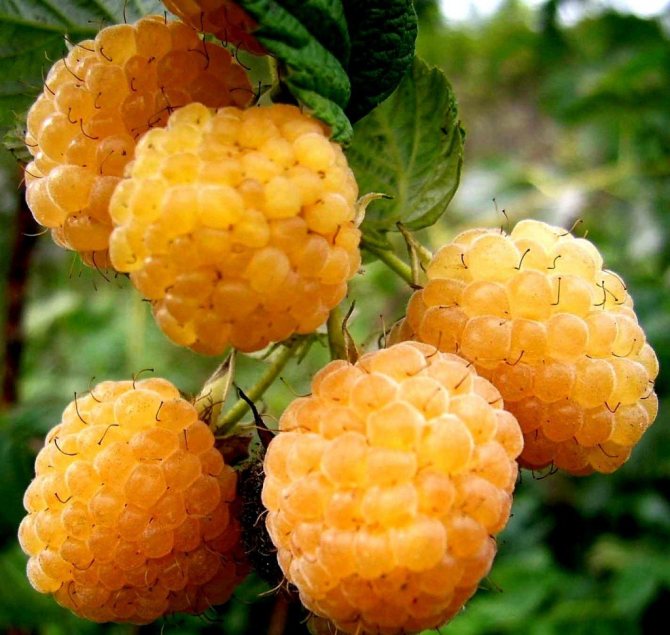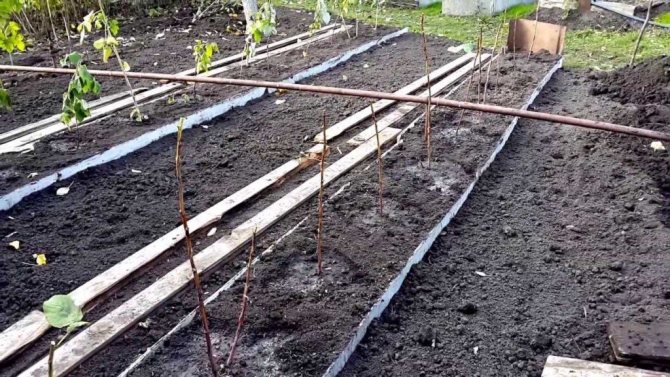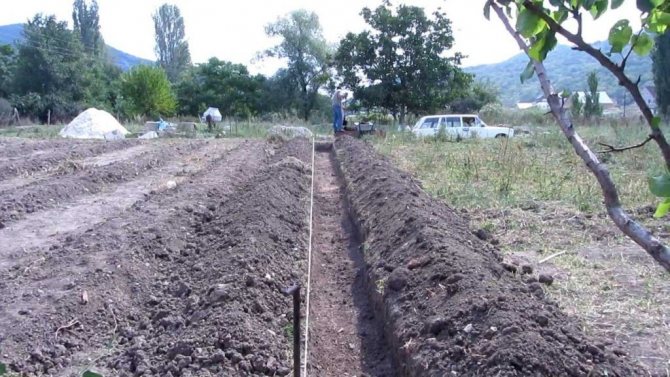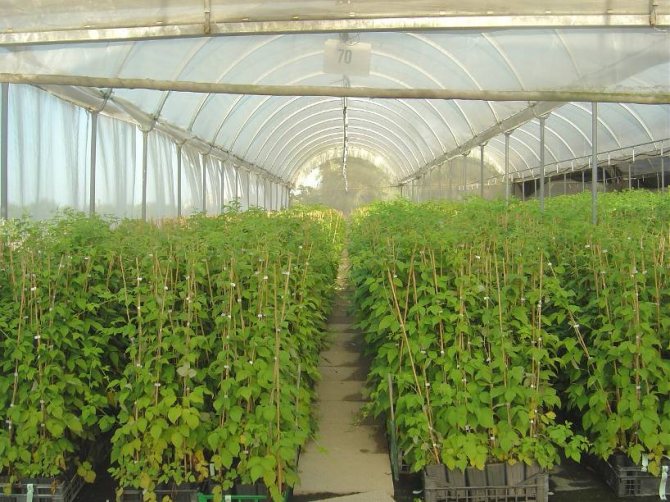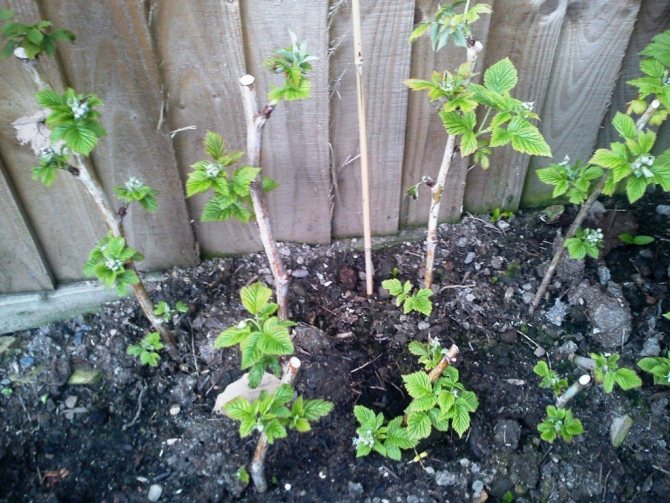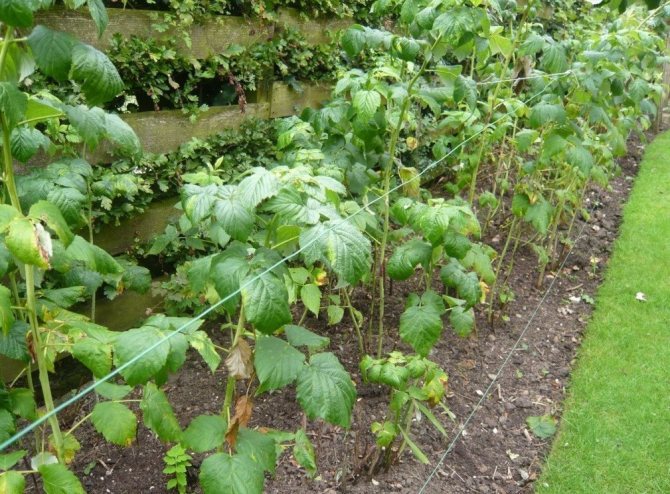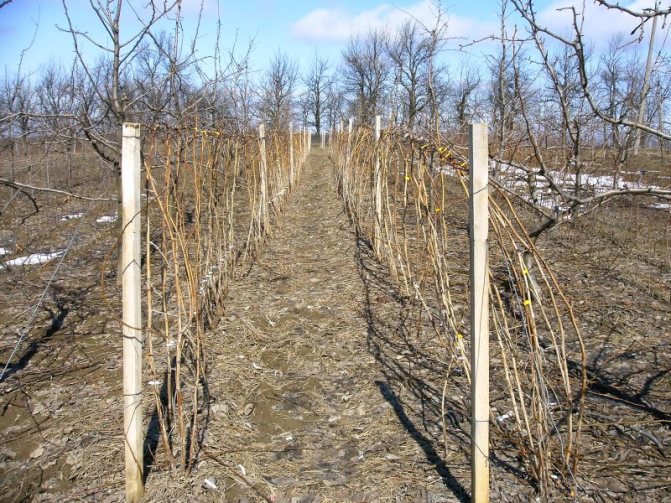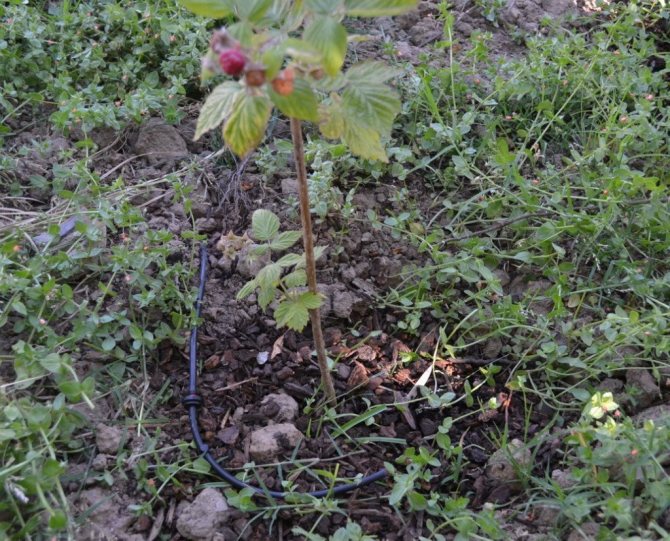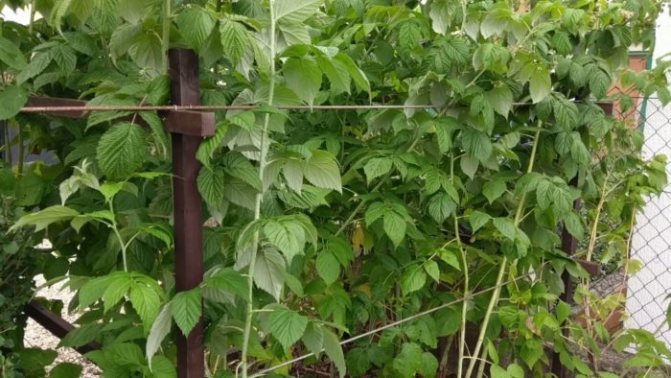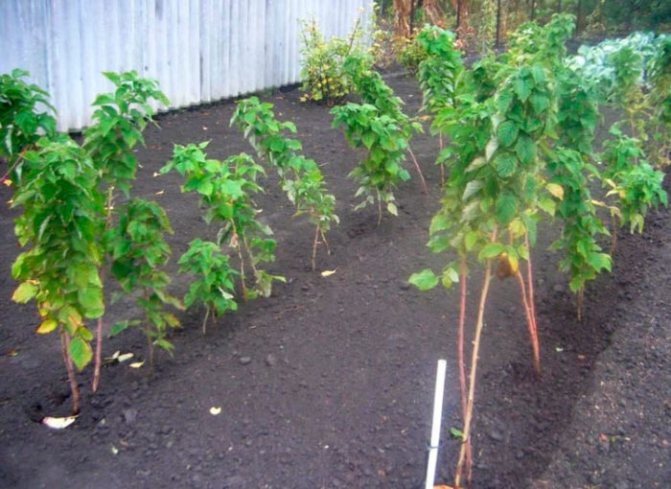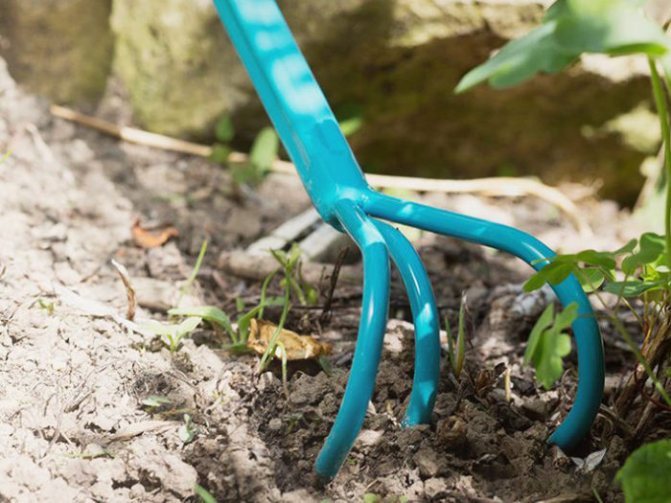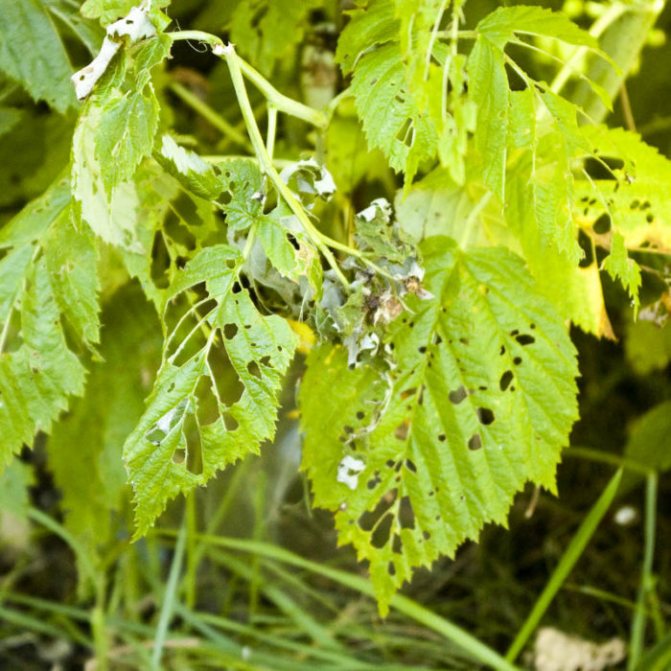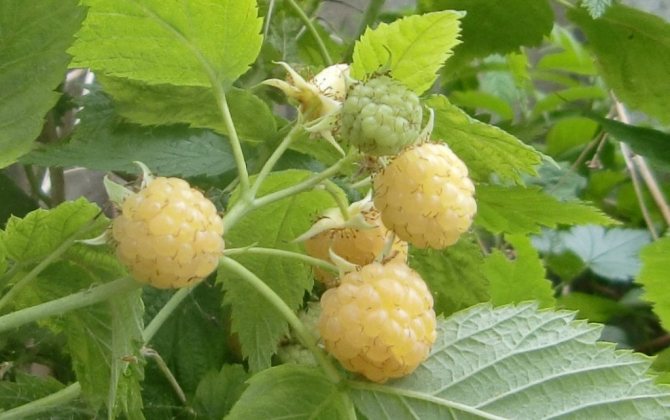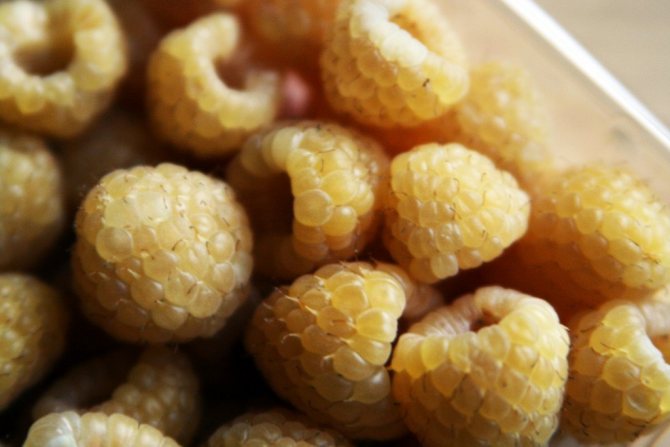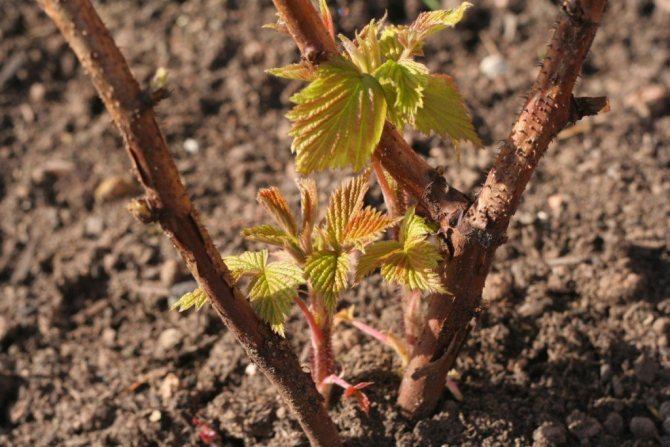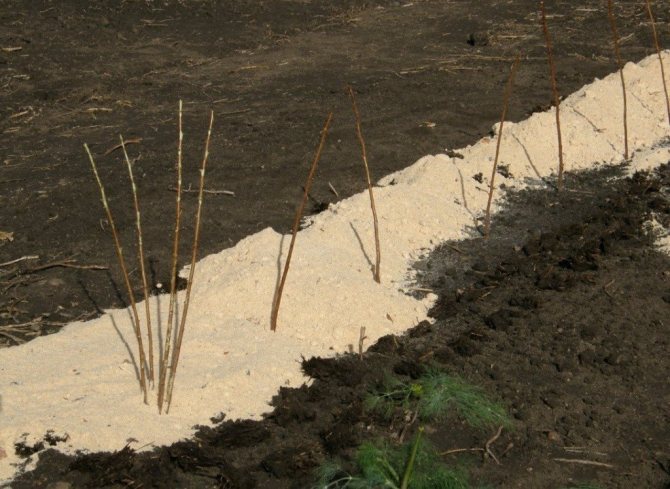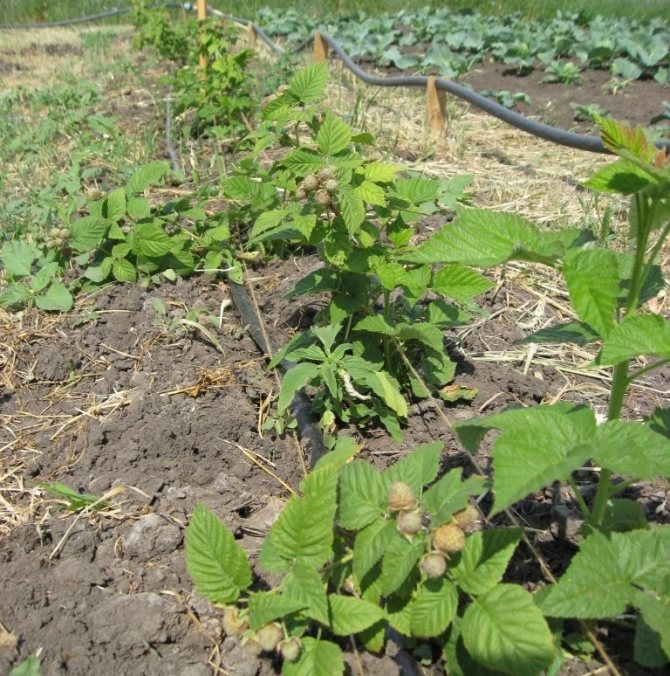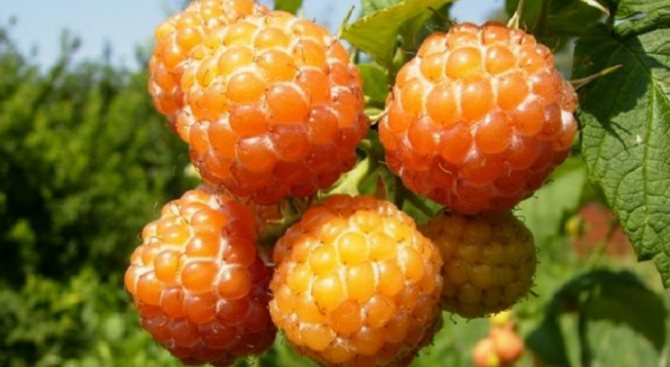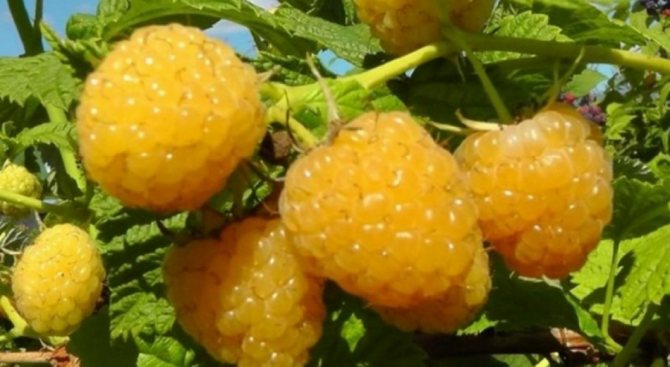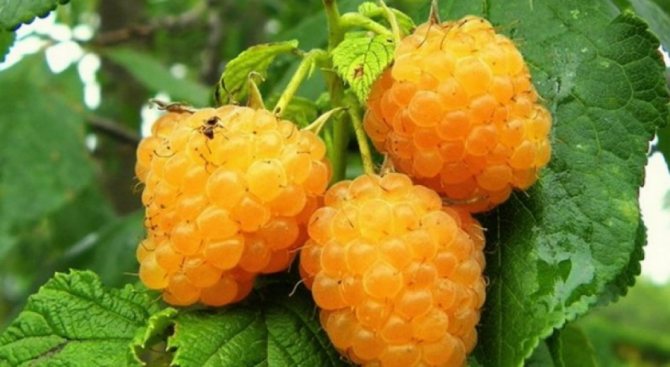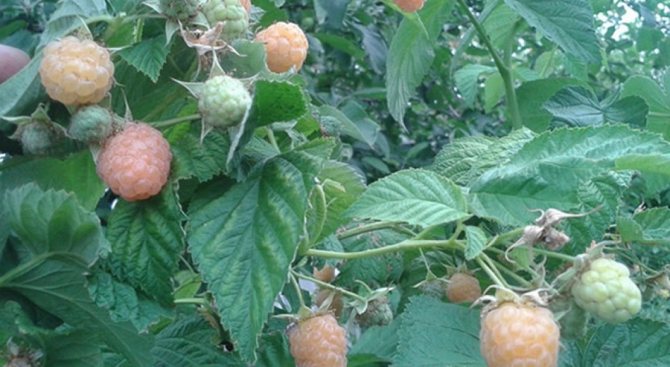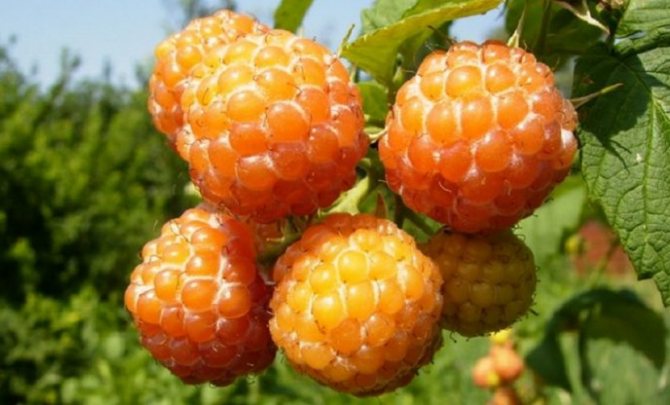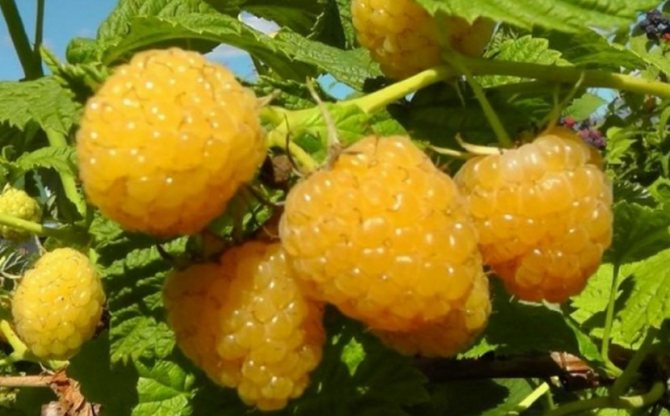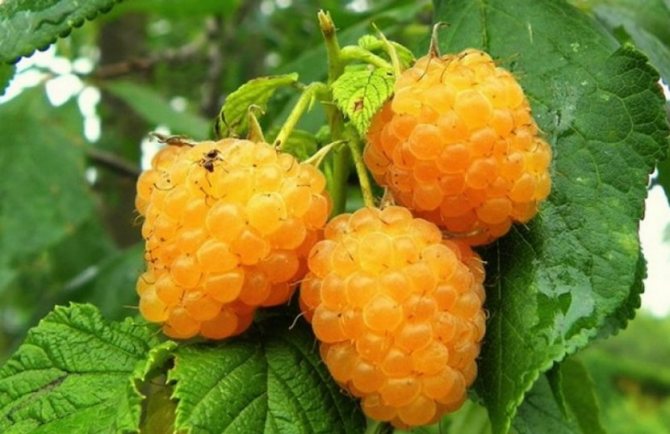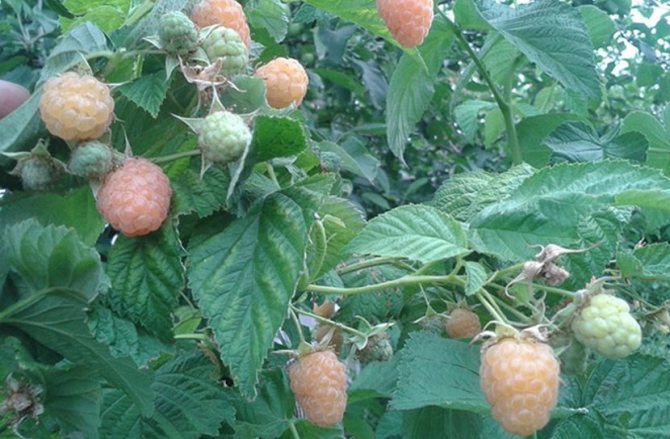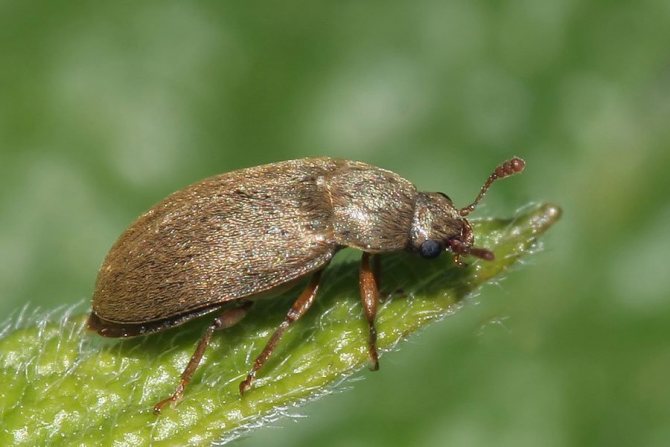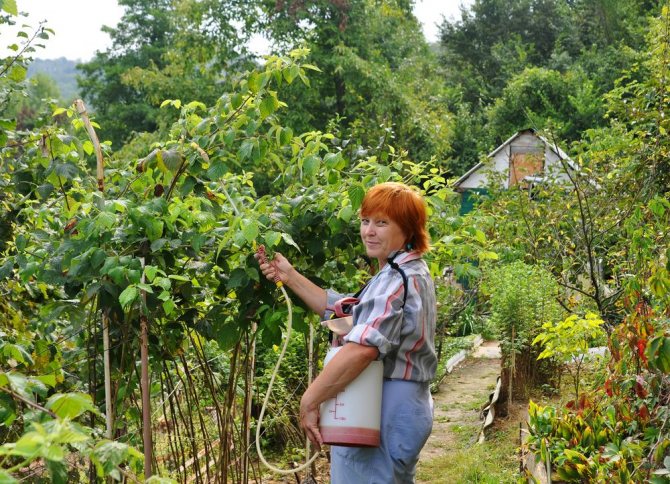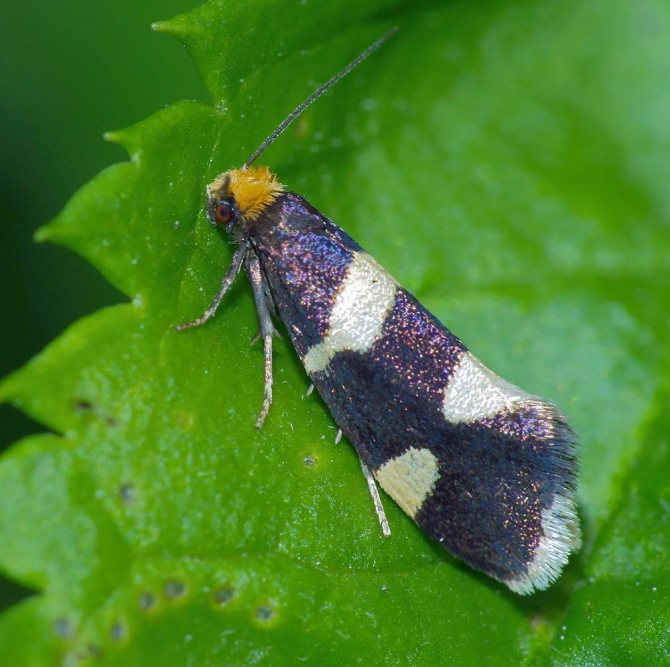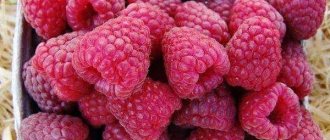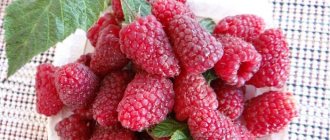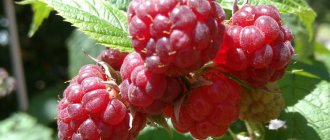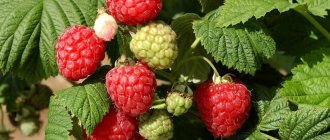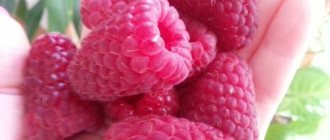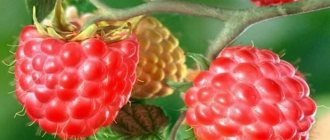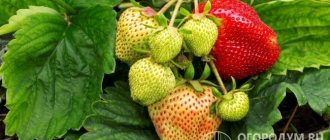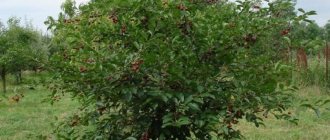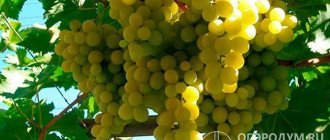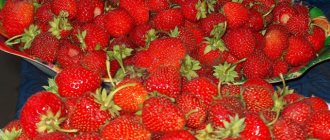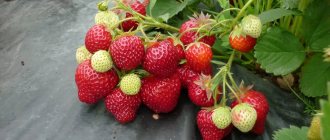Runaway is a yellow-fruited, frost-resistant remontant raspberry variety that is widely popular with gardeners who want to grow universal varieties on their site. Runaway berries are good both fresh and for preparing winter preparations. The unusual yellow and rich orange color makes this raspberry a favorite among children. Fruiting of the variety begins in mid-summer and ends with the onset of frost, already in October.
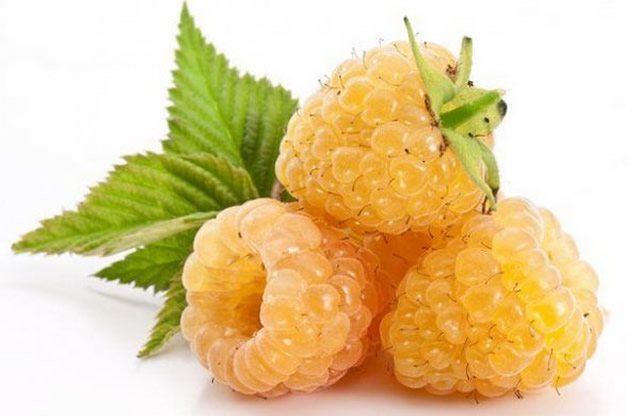
Unusual yellow raspberry Runaway. Description of the variety, photos, reviews
Runaway is a yellow-fruited, frost-resistant remontant raspberry variety that is widely popular with gardeners who want to grow universal varieties on their site. Runaway berries are good both fresh and for preparing winter preparations. The unusual yellow and rich orange color makes this raspberry a favorite among children. Fruiting of the variety begins in mid-summer and ends with the onset of frost, already in October.
Advantages and disadvantages
"Runaway" has both positive and negative qualities.
- Easily tolerates low temperatures.
- The fruits do not ripen at the same time, so it is convenient to eat them fresh.
- Used in garden design.
- Ease of collection due to the height of the shoots.
- Good taste.
- Thorns on the shoots.
- Low yield.
- Inconvenience during transportation.
- Cannot be frozen.
- It shows itself poorly in winemaking.
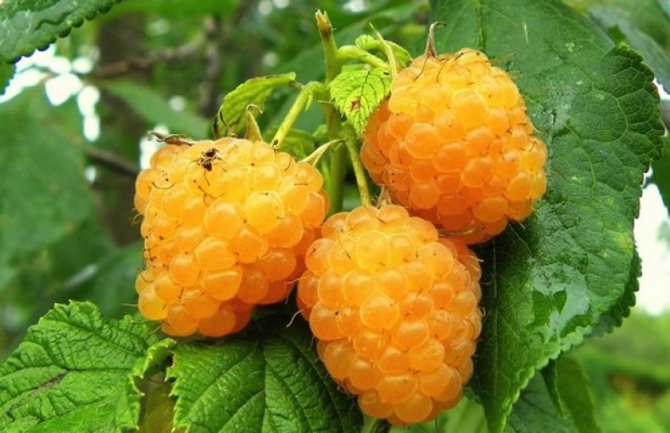

The "Beglyanka" variety is undoubtedly worth growing on your site. You will definitely like the combination of an unusual appearance and excellent taste. Good luck with growing!
Description of the variety
Raspberry Runaway forms medium-sized, growing up to 110-130 cm, having no more than 8 shoots, not spreading, bushes. The stems are erect, requiring tying during the fruiting period, since otherwise, under the weight of the crop, there is a risk of breakage. Thorns are not numerous, green in color, rather stiff. If the harvest is not careful, they can be injured. Raspberry leaves are medium in size, bright green in color.
Runaway berries weighing up to 2.6 g have a golden yellow or deep orange color. The shape of the fruit is round. Taste quality is average (tasting score 4.2). The berries are sweet, with a slight sourness. The appearance of the Beglyanka raspberry, due to the yellow color of the fruit, differs from most other varieties, looks very beautiful, but the transportability of the berries is low.
The variety is resistant to the main diseases of raspberries and frosts, therefore it is suitable for growing in most of the country.
Like all raspberry varieties, Runaway has its own strengths and weaknesses.
Benefits of the variety
- decent taste both fresh and cooked;
- beautiful appearance of yellow berries;
- versatility of use;
- the average height of the bushes, making it easier to harvest;
- high winter hardiness;
- resistance to major fungal diseases and pests;
- a large number of growths for reproduction.
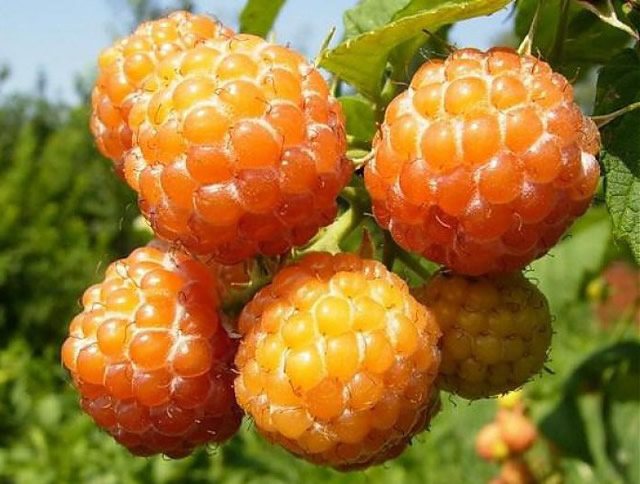

Disadvantages of the variety
- low transportability;
- the presence of thorns;
- average berry size;
- tendency to crumbling drupes;
- the need for trellis equipment.
If you do not need to transport or store berries for a long time, then the variety can be safely planted on your site.
How to prune a crop
With the bush growing method, formative pruning is carried out. A 3-4 year old plant should have 10 to 15 annual shoots. The rest are carved from the ground. Pruning procedures need to destroy weak, densely located branches. The optimal distance between shoots is 40-50 centimeters for raspberries.
Root offspring leave only strong ones, they should not be more than 15 pieces, located 15-20 centimeters from each other. Everyone else breaks out. After 10 years, the plantation is replaced with completely young shoots.
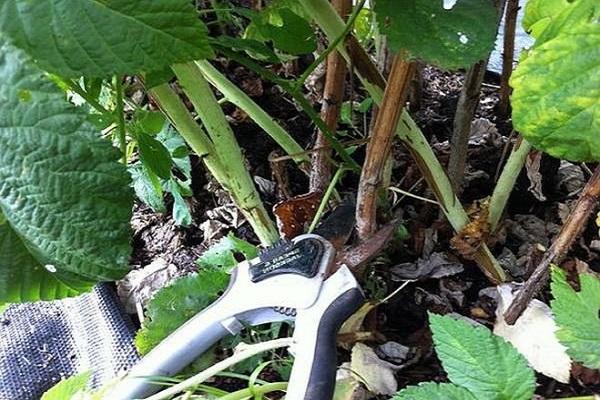

The shortening of the tops of annual shoots affects the quality of the crop. In the spring, you need to trim it by 10-15 centimeters. As a result, fruitful shoots with large berries will appear.
If you cut off one-year-olds in the spring, leaving a stump of 8-10 centimeters, then August and September will delight you with large yellow berries.
Landing
The correct planting of raspberries will largely determine its further fruiting. Also, the quality of the berries obtained depends on how good the place is chosen for the raspberry tree. When the Runaway lacks light, her harvest is meager and acidic in taste.
Perhaps you will be interested! Description of one of the best raspberry hybrids with a half-century history - Maroseyka raspberry.
The plot for the Beglyanka variety needs a sunny, dry, windless one. The ideal place for this raspberry is the sunny side along a dense fence or close to buildings, where the walls can protect the plants from the wind without shading them.
The optimal time for planting Runaways is spring, when the soil has already warmed up, and its temperature will be at least 15 grams. Raspberry seedlings planted at this time have time to get stronger by the fall and develop a sufficient root system to overwinter qualitatively. Also, when planting in spring, it is possible to get a good harvest already next season.
Pits for bushes are prepared in advance (at least a month in advance) so that the earth has time to settle. The earth remaining after digging is mixed with humus in a 1: 1 ratio, wood ash is added (1 glass). Ash is a source of potash and phosphorus fertilizers, neutralizes acidic soil. A mound is formed from part of the nutrient soil at the bottom of the pit. A seedling is placed on it, the roots of which are distributed along the slopes. Then they fall asleep, paying attention so that they do not bend upwards. When planting, the root collar of the seedling should not be buried in the ground. The soil around the plant is compacted, after which abundant watering is carried out.
Garter and watering raspberries
- Along each row of planted raspberry bushes, we stretch wires or ropes in 2 rows: at a height of half a meter and a meter from ground level. To do this, at the ends of each row, at a distance of about 3 meters, we dig in posts, to which we attach these wires.
- Then we tie the stalks of raspberries to the wires so that they do not bend in the wind and from the weight of the berries, and do not form impassable thickets.
- After planting raspberry bushes, do not forget to water it. In dry weather, it is advisable to do this daily, and water abundantly. It is necessary to soak all the ground to the deepest roots, although they are at a shallow depth.
Watering and the necessary feeding will provide you with large raspberries in the maximum amount.
Growing and care
After correct planting, further competent agricultural technology is the key to consistently high yields for many years. Violations in the care of the Runaway often cause a deterioration in the taste of raspberries and their chopping.
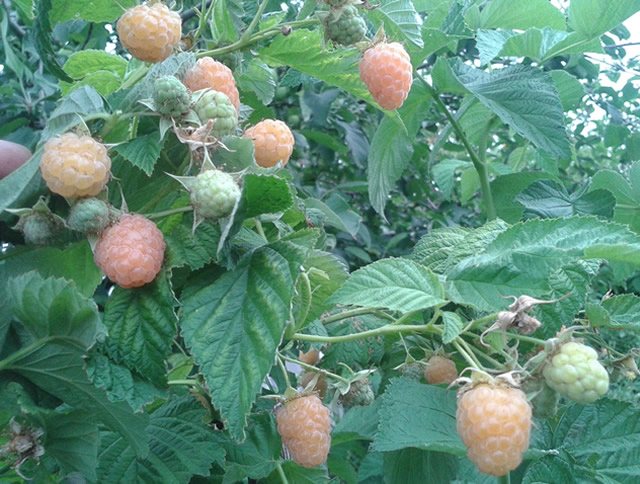

Watering
Watering is an important step in the care of your raspberry. The repairing variety Beglyanka requires watering in dry weather 1 time in 7-10 days. If it rains and the soil is saturated with moisture to a depth of at least 40 cm, then additional moisture is not required.
With a lack of natural precipitation, watering is mandatory before flowering, at the time of active pouring of berries, after fruiting and before winter. To increase the efficiency of watering, a circular trench 15 cm deep should be dug around the plant (at a distance of 30 cm from the trunk). Water is poured into it, which will not spread over the soil, but will penetrate exactly to the raspberry roots.
Pruning
Raspberry Pruning Runaway is carried out in spring and autumn. Only a very sharp tool should be used for it, which evenly cuts off the shoot, without breaking or crushing it. It is important before use, as well as moving from bush to bush, to disinfect the pruner in a weak solution of manganese.
In the spring, all shoots damaged during wintering are cut off. If only their tops are frozen, then the shoot should be shortened to the first healthy bud.
In the fall, all non-lignified green shoots, diseased branches, as well as those left over from the last season are cut off (they will no longer bear fruit). They should be cut at the root. Thus, for the winter, only lignified shoots of the current season should remain on the plant, on which there are no signs of any diseases or pests.
Top dressing
Feeding raspberries Beglyanka is carried out throughout the growing season. In the spring, as soon as the plants begin to develop, nitrogen fertilizers are applied. They are necessary for the rapid growth of the green mass of the bushes.
At the time of laying the buds, the raspberries should be watered with a solution of chicken manure in water, prepared in a ratio of 1:20. You can also use mullein, but in a 1:10 ratio.
Before the start of the active pouring of berries, the Runaway is fertilized with potassium-phosphorus fertilizers. They are also brought under the bushes in the fall, preparing raspberries for winter. These substances strengthen the plant and increase its endurance. Wood ash is rich in potassium and phosphorus, which, in addition, allows to reduce the acidity of the soil, namely, acidic soils are most common in Central Russia.
A good result is given by feeding the Runaway with herbal infusion. To prepare the fertilizer, the barrel is half filled with grass, poured with water, a tablespoon of nitrogen fertilizer, for example, urea, is added and allowed to brew for 10-14 days. Then dilute the solution with water in a ratio of 1: 3 and pour the raspberries under the root. The remaining grass is laid out in the aisles. Fermented grass will serve as an excellent mulch, it does not bind the nitrogen of the soil, while protecting the soil from drying out, decomposing, nourishes the soil.
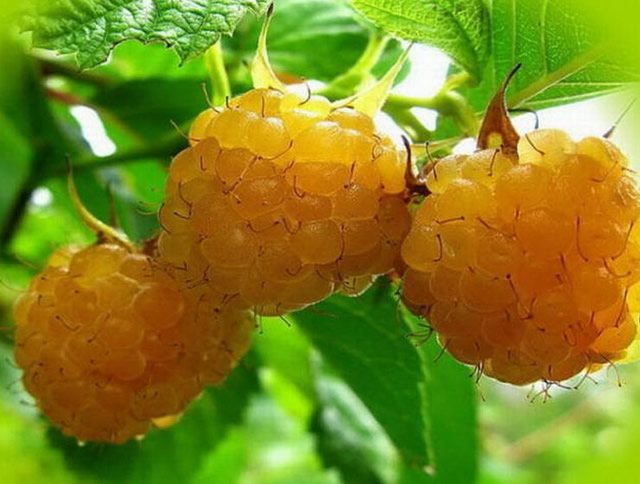

Preparing for winter
The Beglyanka variety is characterized by increased winter hardiness and does not need shelter. After pruning, the remaining shoots should be tied together so that the bush does not break with heavy snow. If severe frosts can be expected, then it is useful to wrap the bushes with non-woven covering material (ultrasil). There is no need to bend down to the ground and cover the bushes more thoroughly.
Reproduction
Reproduction of raspberries Runaway is carried out by root suckers, which are formed in significant quantities. They are separated from the parent plant in spring or mid-August. They are planted in the same way as seedlings, which are acquired primarily to create a raspberry tree.
Popular varieties
There is an obvious paradox in the very name of this variety! And the "biography" of the berry may seem dubious. After all, she is a mutant. Yes, yes, no one deliberately brought her out, so strange. It's just that once it was formed as a result of a mutation, and then they began to multiply it.
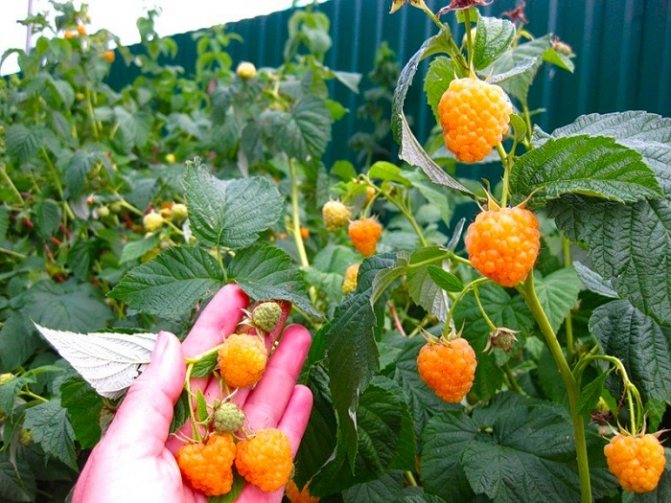

But do not let these seeming oddities mislead you, dear gardeners. Unusual in appearance, this berry is in no way inferior to its traditional relatives and even has some advantages. For example, it causes allergies much less often.Nature has talentedly combined sweet and sour shades in her taste, accompanying them with a pleasant aroma. "Non-Malinus Raspberry" is literally applicable to everything. Enjoy it fresh, make jams and jams, create wines and liqueurs.
If you have not planted these bushes on your site yet, it's time to correct the omission. Choose the variety you like. Each of them has its own advantages. Fragrant "Sweetheart", prolific "Yellow Giant", bringing fast harvest "Golden Fool", viable "Apricot". Popular varieties of yellow raspberries have rightfully won the sympathy of gardeners.
Yellow giant
In the amber-colored family of berries, the Yellow Giant variety is perhaps the best known. And for good reason! He lives up to his name one hundred percent. The bushes are not too sprawling, but they quickly reach for the sun, reaching 2.5 m in height. On strong stems there are large flowers, which then turn into berries - huge, about the size of a walnut. Each branch has two dozen bright yellow lanterns. One bush of "Giant" with careful care will reward you with an excellent harvest, 3-6 kg.


In normal practice, new varieties are created by crossing. And the Yellow Giant is a clone. That's right, it was created in the laboratory by cloning. The result pleased the authors. The variety is different:
- rare yield;
- large berries;
- easy and fast reproduction;
- the ability to bear fruit from mid-summer to late autumn;
- pleasant taste and aroma of juicy berries;
- good health.
The "yellow giant" is not suitable for growing in industrial batches - delicate berries are not suitable for transportation.
But all of its characteristics are ideal for a summer residence or a personal plot. One should only take into account the peculiarity of the variety: the root shoots are developing rapidly, "Giant" is able to capture the entire area, if the root suckers are not removed in time.
Well, giants are also entitled to whims. Moreover, he will pay back generously to those who will carefully look after him.
Morning dew
Do you want to grow sunny raspberries not only for yourself, but also for a small business? Pay attention to the Morning Dew variety. Specialists from the Polish Institute of Horticulture and Floriculture worked on it, and in its homeland it is called Porana rosa.
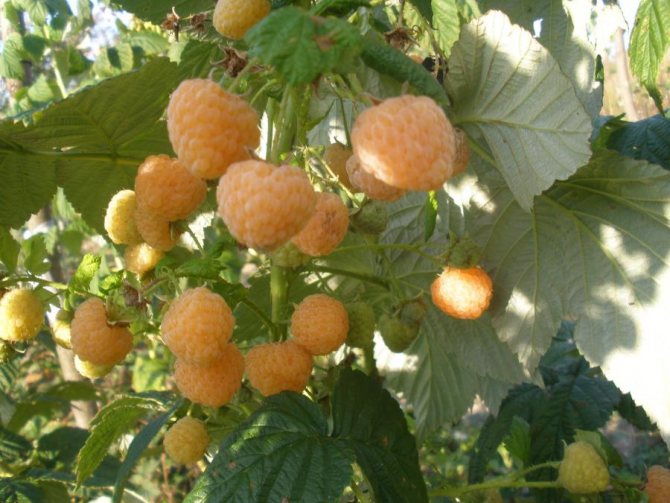

This is a variety for gourmets who don't like the sugary sweet taste. Round golden berries are pleasantly sour. They are very large, 4-8 g, and taking into account the abundant harvests (one bush brings up to 3 kg) "Morning Dew" needs a garter. Yes, the straight stems are strong, but also very tall, the bushes grow under two meters. Therefore, branches heavy from berries must be supported.
This is a remontant raspberry. The ripening time for "Morning Dew" is autumn, early September. As soon as fruiting is complete, experts recommend immediately cutting off the ground part of the bushes for a better harvest. Note that this variety can also bear fruit twice a year, but experts recommend choosing quality over quantity.
"Morning dew" is quite unpretentious, it is not for nothing that it is called a work-worker variety. Resistant to heat and frost, to diseases, the most productive among the remontant varieties, transportable - this is rarely yellow raspberry, and red too. This variety is rightfully considered one of the most promising.
Yellow sweet tooth
Yellow Sweetheart is an attractive title, isn't it? And not only the name - you will be convinced of this when you get to know the variety better.
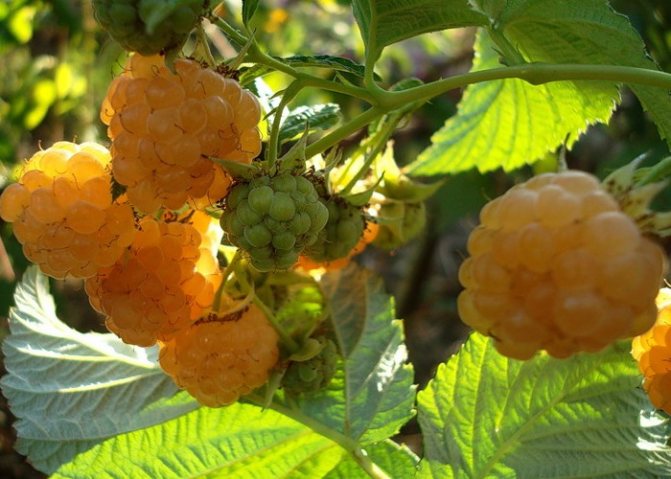

Choosing just such a yellow raspberry for your personal plot, you choose:
- unusually tasty and aromatic berry;
- rich harvest (about 3-8 kg per bush) from mid-July;
- a plant with powerful "health", resistant to pests and diseases.
This masterpiece of domestic selection was created at the Research Zonal Institute of the Non-Black Earth Belt in 1990 and since then has repeatedly confirmed its excellent qualities. "Yellow sweet tooth" does not require excessive attention to itself.The main thing to remember is that the shoots should be covered for the winter. Despite the fact that breeders crossed the original variety with a donor of winter hardiness during breeding, you need to take care of "Slasten" in the cold - unless, of course, you live in the south.
In general, caring for this variety is not a problem. Gardeners will certainly appreciate the fact that the bushes are devoid of thorns. And ripe berries stay on the bush for a long time, they are in no hurry to fall.
Harvesting is easy: "Slastena" rarely grows more than 1.5 m. In a word, an excellent option for a summer residence, delicious berries that your whole family will love.
Orange miracle
The cultivar of the future, the elite of remontant raspberries - such flattering characteristics give agricultural technology to the Orange Miracle cultivar. And these are not empty compliments, but a statement of fact.
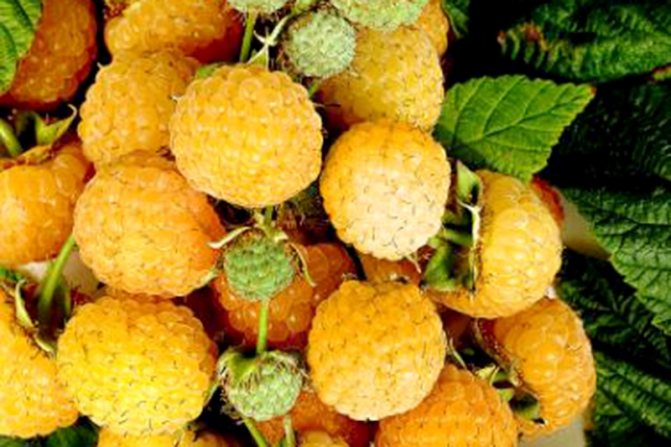

Judge for yourself. This raspberry can be planted on any soil and, according to the authors of the variety, in any climatic conditions. It does not require undue hassle as it is almost invulnerable to pests and diseases. Ripe berries hang on the bush for a long time. And these amazingly beautiful orange berries begin to ripen somewhere in the middle of August. The end of fruiting is late autumn, the time of the first frosts. Large (6 g on average) berries are delicately sweet, juicy and very aromatic.
Another rare advantage for yellow raspberries is that the variety is transportable. "Orange Miracle" can be grown not only for intra-family use, but also for sale. As a modern variety, "Miracle" is spared by breeders from many disadvantages.
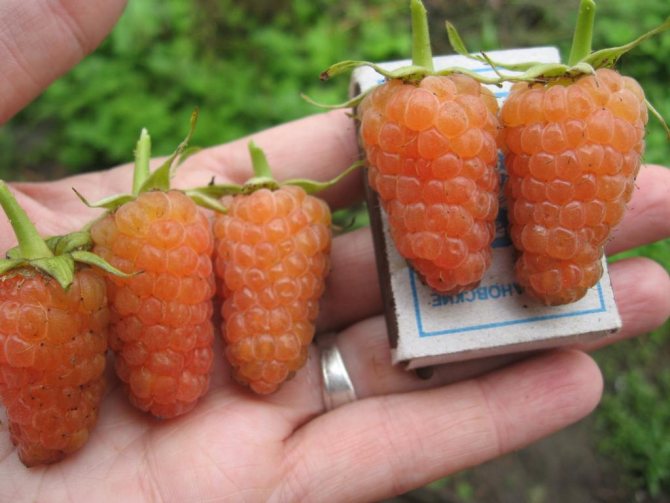

Breeders position the variety as resistant to any conditions, it does not need intensive feeding and super-protection from pests. But there are conditions that the Orange Miracle will especially like. There is nothing unusual about them: a sunny place for planting and sufficient watering of the seedlings. Well, and a garter of bushes, because each of them promises a yield of 2-2.5 kg. Orange lights of ripe berries will greatly decorate your site.
Apricot
Do you like raspberries really sweet? Then forget about the usual "red" varieties. Yellow "Apricot" is what you need.
The variety owes its name to its unusually beautiful color, which really looks like a ripe apricot. Delicate yellow-orange shade with the finest pink tan looks fantastic. But at the same time the taste and aroma are the most raspberry.
This wonderfully beautiful berry is intended for children, it seems, by nature itself. No sweets can be compared with the taste of berries, and it is easy to pick them: the bushes are not tall, they rarely stretch more than 160-170 cm. And on the top of the branches there are no thorns at all.
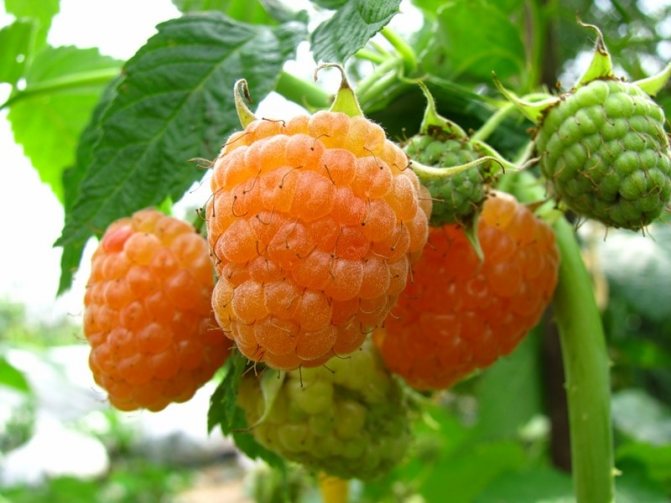

A not very large-looking bush will bring an excellent harvest - up to 4 kg. Of course, one of the advantages of the "Apricot variety" is its remontability. The first berries will ripen by mid-summer. And the second wave of the harvest - until the first frost.
The "apricot" raspberry is rather tender; it is best suited to a moderately warm climate. In the cold and dampness, the berries are destroyed by decay. And the heat and drought do not allow the taste to fully develop. But in pleasant conditions, it will delight you both in summer and winter. Jam from "Apricot" is not only very tasty, but also magically beautiful.
Testimonials
I was pleased with the variety. The first time I planted 4 yellow raspberry bush for testing a few years ago. Fruiting is good, taste too. However, it is impossible to say that the berries are delicious, it would be more correct to call them dessert. Of the shortcomings, I can only note the presence of thorns. By root suckers, he increased the number of bushes to 20. My personal opinion is that it is necessary to grow the "runaway" in combination with some other dessert variety.
Fairly good raspberry in relation to yield and frost resistance. But I am not very happy with its taste because of the pronounced sourness. This does not interfere with processing, but if there are fresh berries, then the lack of sweetness for me is a significant disadvantage.The shoots form quickly, and if desired, you can get a large raspberry tree in a short time. I will leave the fugitive, I will make jam from it, and I no longer have varieties of yellow raspberries.
Gardeners reviews
Maxim, Skopin: “I planted 4 runaway bushes 5 years ago. The variety is not bad. But the berries are sour for my taste. The advantage of this variety is the abundant growth of the growth: during the cultivation, the number of bushes increased to 20 pieces. I like the continuous formation of berries. All summer and at the beginning of autumn I collect fresh berries for the table. "
Igor, Moscow region: “I love the Runaway for her bright apricot color. The berries are sweet and sour, although there are few of them on the bushes compared to other varieties. I feed the plants only with organic matter: mullein or chicken dung. I don't cover for the winter. "
Natalia, Makhachkala: “The fugitive makes me happy with tasty and large berries every year, although there are not many of them ripening on the bushes. But the plus is that the berries ripen constantly - from the end of June to the end of September. Flowers bloom until the very frost, and it's even a pity to watch them die. "
5 / 5 ( 1 voice)
Description of the raspberry variety Beglyanka
Stems are medium-sized, within 1.3 m. Slightly spreading, with up to 8 shoots.
Straight lines, with a green color in the first year of growth and a transition to gray in the second year of development. It has small thorns, but small in size, light green in color.
The leaf is bright emerald of medium size, wrinkled with a slight waxy bloom. The edges have pointed teeth.
Fruit
Raspberries Runaway apricot color with a golden sheen. Round-conical shape. The taste is delicate sweet and sour with a raspberry aroma.
Fruit weight up to 2.7 grams. Used fresh, for conservation.
When all agrotechnical recommendations are followed, the bush can produce up to 2 kg of berries.
Jam and compotes obtained from Beglyanka raspberries have a beautiful light color.
General characteristics
Raspberry Runaway has medium resistance to dry season and high temperatures. The variety was bred for central Russia and is able to withstand low temperatures.
The fruiting period lasts from mid-July to mid-October.
Optimal conditions for planting raspberries Beglyanka
The soil
Raspberry Beglyanka prefers neutral or slightly acidic soils, with fertile soil. In highly acidified soil, it is necessary to add lime when digging, up to 3-5 kg per 10 square meters.
It is also necessary to apply fertilizers. If you plan to plant in the spring, then deep digging and fertilization is done in the fall.
- cow dung,
- chicken droppings,
- compost,
- wood ash.
Groundwater location
The roots of the raspberry tree are located in the horizon of 1-1.2 m. The proximity of groundwater less than 1.5 meters will not allow the plant to develop well and will contribute to decay of the root system.
There are two options to prevent this:
- plant a plant on a hill,
- apply drainage, which will lower the water table.
Landing features
The algorithm of actions for planting yellow raspberries is as follows.
Step 1. First, holes of the appropriate size are dug so that the root system of the seedlings is reliably covered with soil.
Step 2. Further, compost or humus is poured into each of the holes, and a small amount of wood ash is also added.
Step 3. All these "additives" are thoroughly mixed with the soil. The resulting mixture is diluted with a small amount of water in order to achieve a mushy consistency.
Step 4. After that, a yellow raspberry seedling is placed in each hole. The pits are buried, the soil is well compacted.
Step 5. At the end, the soil around the planted bushes is re-watered. This must be done around the entire perimeter and exclusively at the root. In parallel with this, care should be taken that the soil is not accidentally washed out and the roots of yellow raspberries are not exposed.
Note! It is advisable to plant a crop in rows - this way you will greatly facilitate its further maintenance. Within each row, there should be some distance between plants, but not less than 50 centimeters.
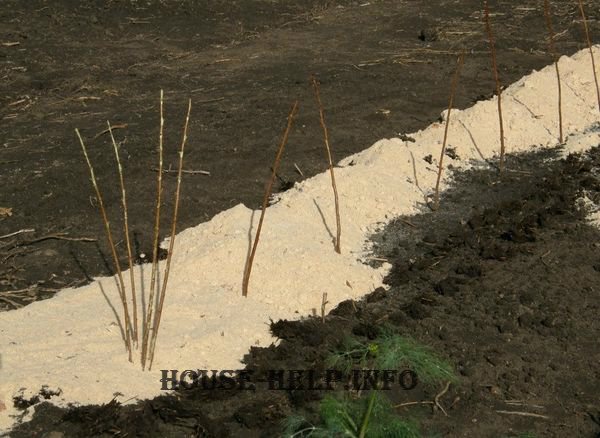

And if you plan to plant a large number of seedlings, then it is advisable to dig holes and prepare for planting in advance, so that after buying a crop there is no need to do everything in a hurry. This can harm the bushes, which, accordingly, will lead to a deterioration in the yield.
- Each row of holes breaks out about a meter from the others, at least. It is characteristic that this distance can be increased up to two meters, since the yellow-fruited raspberry is a light-loving culture and it should be planted in the place where a minimum of shadow will fall on it.
- In addition, the culture is very fond of water. For this reason, it is necessary to plant it in lowlands and all kinds of depressions, and not on hills. With this, it is important not to overdo it and not select lowlands with stagnant water for planting. Excess moisture is harmful even for raspberries.
Video - Planting culture
Planting raspberries Runaway
Planting raspberries of the Beglyanka variety (and any other) in places where tomatoes and potatoes previously grew, due to the similarity of diseases, is categorically not recommended.
The first step on the way to a high-yielding raspberry plant is the choice of planting material, whether the gardener's work will be crowned with success depends on its quality, infection with viral diseases and all sorts of parasites.
Selection of seedlings
- Choose strong, smooth shoots without visible cracks and neoplasms, this will prevent the infestation of the future raspberry with parasites.
- Do not buy raspberries with leaves, successful planting is possible only on a green cone, otherwise the seedling will simply die, despite all the efforts.
- Pay attention to the condition of the roots, a healthy appearance and a good length (about 15 centimeters) will ensure fast growth and, accordingly, a bountiful harvest.
- The thickness of the root collar is 8-10 centimeters.
- The outer part of the shoot should be with characteristic species characteristics and a length of 40-45 centimeters.
Important! Do not buy raspberry seedlings hand-held. No one can guarantee the purity of the variety and infection with various diseases and pests. Warranties can only be obtained from specialized farms.
Reproduction
It is possible to dilute the Runaway raspberry on the site with the help of cuttings, apical layers, but the easiest way is to root shoots. It is necessary to carefully, with an earthen lump, dig out the layering and transplant to the designated place.
Site preparation and planting procedure
The area chosen for the raspberry tree must be prepared in advance.
- The first and, perhaps, the most important stage is a thorough cleaning of all weeds, pests can hide in them and raspberry diseases develop.
- Digging the site, if possible with the addition of ready-made manure, this will increase the yield.
- We make landing pits. With a shovel, we dig out recesses of about 55 centimeters and measuring 50 by 50 cm.
- We fill the pits with prepared manure and plant residues, fill them with earth on top.
The planting time of seedlings depends on the region. For example, in the northern regions with a rather wet and long spring period, and an early onset of frost, it is better to abandon the autumn planting. It is better to plant raspberries in the spring to avoid freezing of young seedlings.
In the southern regions, on the contrary, the spring survival rate is much lower, due to the rapid onset of drought. The ideal option would be late September-mid-October.
Landing scheme
Planting the Runaway raspberry can be done in one of two ways:
In the holes
Holes are dug out with dimensions of 0.5 square meters. The excavated soil is mixed with rotted manure, with the addition of wood ash.The roots of the seedlings are moistened with Kornevin and a talker, and gently lowered into the hole.
They are covered with earth mixed with fertilizer. They are slightly compacted and poured with a bucket of water to remove inter-root voids. The distance between the holes is chosen about 1 m.
In the trench
Digging a trench up to half a meter deep and wide. Both mineral and organic fertilizers are introduced into it. Then they are covered with a layer of 15 - 20 cm. Seedlings are planted on top of this layer and covered with the remaining earth.
A little tamped and watered. All seedlings, both when planting in holes and in a trench, will be mulched. To do this, you can use rotten straw, sawdust, pine needles.
For the rooting of seedlings, soil moistening must be carried out daily. This watering should be small in volume to avoid root rot.
Every gardener knows that without proper care a decent harvest cannot be achieved, it takes a little effort.
Watering raspberries Runaway
Without additional watering, you will not be able to get a high-quality harvest of raspberries. The Runaway will not work. It is carried out 1-2 times a month, and in sufficient quantities (8-10 liters) for a bush. In drought, the frequency of watering increases.
The water should be warm, watering directly from the well will lead to stress and death of the roots as a result of a sharp temperature drop. Watering is done in the evening, after the heat has subsided.
It is also necessary to ensure that water does not fall on the leaves and stems; sometimes one drop is enough for the development of viral diseases, and in conditions of high temperatures, the process of reinfection occurs very quickly.
The ideal option for irrigating a raspberry tree is drip irrigation.
Top dressing
Feeding raspberries Runaway is carried out throughout the growing season. Dilution of fertilizer in water is allowed, combining top dressing and watering.
They begin to fertilize raspberries with the appearance of the first leaves; for this purpose, an infusion of mullein or chicken droppings is best suited.
Fertilization with ready-made (rotted) manure gives a good result, one bucket per bush will be quite enough.
With the beginning of flowering, it is necessary to add potash and phosphorus fertilizers to organic feeding (10 kg of each fertilizer is applied to a bucket of organic matter).
The last feeding, if necessary, is carried out in the fall.
In summer, top dressing with ash is effective. It is necessary to fill the gaps between the rows using 0.5 liters per square meter.
Before each fertilization, the soil in the raspberry grove must be fluffed up and the mulching straw removed, and the peat must be dug up. Nutrients will sink into the roots faster.
Weeding and loosening
After each watering, it is recommended to weed and loosen the soil.
Pruning
Raspberry Pruning Runaway is carried out both in the spring and in the fall.
In the spring, branches affected after wintering are cut off. In the fall, biennial and diseased shoots are cut. This should be done when the crop is harvested and the foliage is completely decayed.
After planting, the raspberries must be trimmed, leaving 15-20 centimeters. In order to form a bush, pruning must be done in May.
A large number of replacement stems (10 pieces) and root shoots (7-8 pieces) will significantly reduce the yield. Leave 5-6 shoots per bush and 13-15 per meter with a trench planting method.
Further care
So, yellow raspberries appeared on your site, planting and caring for which are quite traditional for this plant. One of the important parts of grooming is watering. Raspberry loves to "drink", but excessive moisture is harmful to her, so we are looking for a middle ground.
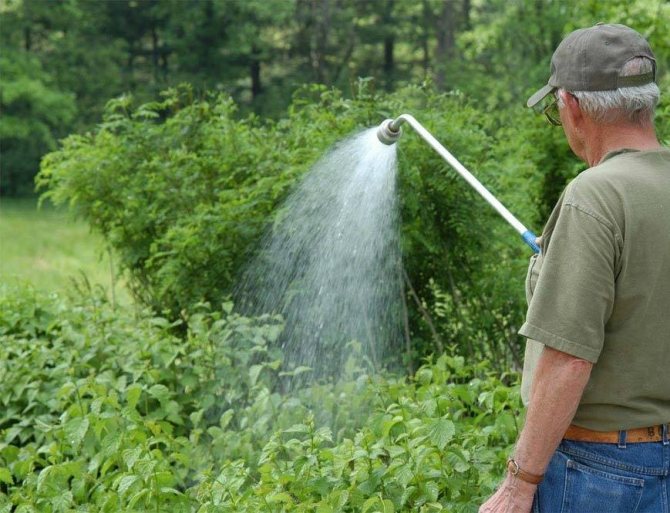

Excessive thickening is also not good for it. It is very important to remove excess shoots and root processes in time. By doing this, you will provide the bush with both an adequate supply of nutrients and good lighting. And these are the necessary conditions for obtaining a rich harvest.
Therefore, we will highlight four main points:
- sufficient, timely watering;
- thorough, but careful, not damaging the roots, loosening the soil;
- top dressing during the period of active growth (early summer - nitrogen fertilizers, the second half - complex);
- timely removal of excess shoots.
Of course, you need to remove the weeds among the raspberries. But there is no need to throw them away or destroy them. Throw them under bushes: as the weed rotted, the weeds will feed the raspberries and create a mulching layer.
When and how to prune the bushes? The first snow and frost is a signal for the gardener: the time has come to prepare the bushes for winter. You should not cut them before the snow. After all, this plant makes good use of autumn before frost: raspberries accumulate nutrients for the next season in order to actively grow and bear fruit well.
Preparing for winter, you need
- completely cut off the top of the raspberry bush;
- remove fallen leaves and loose berries;
- perform shallow loosening of the soil;
- complete the process with mulching.
For the winter, remontant varieties must be covered. After all, the roots with buds are in the ground. For shelter, fallen leaves or sawdust are used.
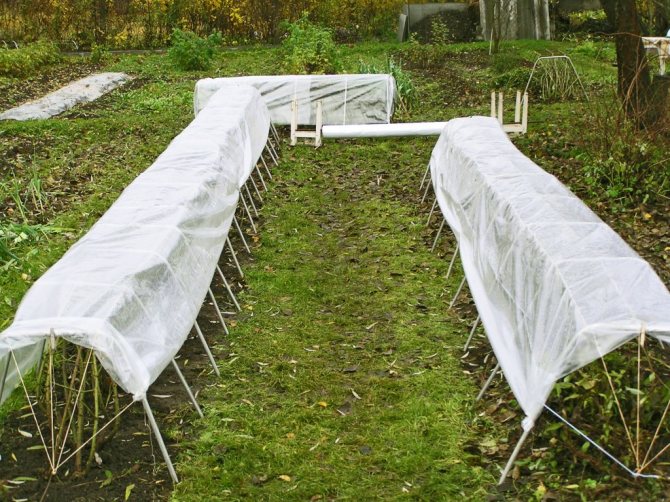

In general, agricultural technology is not specific. If you have experience in caring for red raspberries, you can apply it with success.
Diseases and pests
Any variety, and the Runaway raspberry is no exception; to one degree or another, it is attacked by pests and viral diseases. In order to prevent them, each gardener must systematically inspect the plantings, identify and destroy parasites, and carry out preventive treatments.
A good result is obtained by double treatment with an interval of 14 days with 1% Bordeaux mixture, but you need to be in time before the beginning of the flowering period.
Raspberry gnat... They fight him until the moment of budding, a week before the moment of flowering. Drugs such as Alatar, Iskra are used.
Crimson weevil... The same drugs are used as in the first case.
Spider mite... Use garden, colloidal sulfur, Fufanon.
Sprout gall midge... Seals “galls” appear, chemistry is useless, it is necessary to cut and burn the affected branches.
Raspberry Variety Runaway
A yellow-fruited raspberry called Beglyanka recently earned the right to be called a variety and was officially entered into the State Register of Breeding Achievements of the Russian Federation only in 2009, after eight years of strict variety testing. However, long before that, it fell in love with many amateur gardeners for its early maturity, breeding activity, winter hardiness, weak thorniness and unusual golden apricot color of berries when fully ripe.
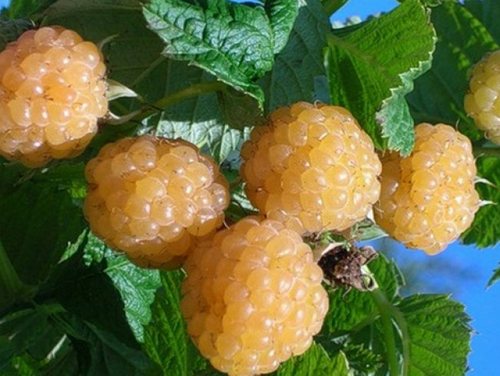

The author of this pictorial form is the well-known Russian scientist, world-renowned cultural specialist, Honored Scientist of the Russian Federation Ivan Vasilyevich Kazakov. He worked for many years, and then headed the Kokinsky stronghold of the All-Russian Selection and Technological Institute of Horticulture and Nursery (VSTISP), where he managed to achieve excellent results, presenting the world with dozens of amazing varieties of raspberries, which together made up the "golden series of Kazakov varieties." Our heroine was one of the last to be included in this list.
Currently, it continues to be popular more among amateurs than professional manufacturers. The latter lacks high yields and transportability in the variety, and, in principle, yellow-fruited varieties are less interesting to farmers in our country than traditional red ones. At the same time, the variety is officially approved for industrial cultivation and zoned in the Central region of the Russian Federation, which includes Moscow, Vladimir, Smolensk, Ryazan, Tula, Ivanovskaya, Kaluga and Bryansk regions. At the same time, the geography of amateur cultivation is much wider.
Features of yellow raspberries
The yellow variety of raspberries belongs to perennial shrubs, reaching a height of 1.5-2 meters. With good care, the plant can stretch up to 3 meters. By its characteristics, the culture is close to its relatives.Therefore, when asked whether it is possible to plant yellow and red raspberries next to each other, they answer in the affirmative. So you can improve the decorativeness of berry plantations.
Representative of the Rosaceae family:
- undemanding to heat, poorly tolerating heat;
- grows better in the shade of trees;
- sensitive to lack of moisture due to shallow root system;
- develops better on soils filled with organic fertilizers.
The raspberry root system is classified as a perennial type. It lies 30-40 centimeters from the surface of the earth. The roots do not go deeper than 85 centimeters into the ground. Horizontally, the roots go 3 meters to the side. Buds are laid on them, from which young shoots appear. By the fall, the formation of root suckers occurs. Shoots also develop from the base of the uterine stems. They replace the branches that have matured, which die off by autumn.
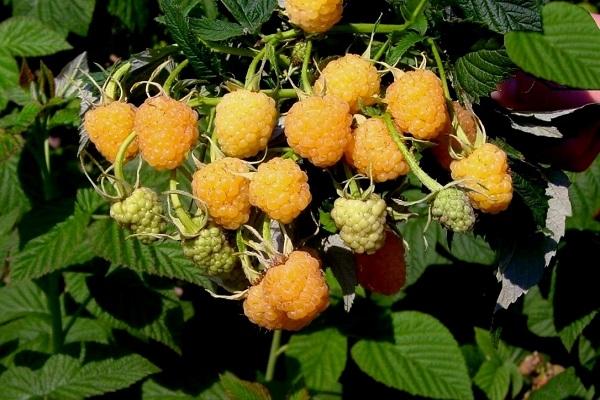

Agrobiological properties
The bushes have an average vigor of growth, not exceeding one and a half meters in height. Replacement shoots are formed in significant quantities - usually 7-9 pieces, forming sprawling plants in appearance. In the first year of life, the stems are not pubescent, painted in a light green color and covered with a light layer of waxy bloom. Spines on them are concentrated at the base, they are very short, straight, not too hard, greenish in color. Thanks to this feature, bushes care and harvesting are greatly simplified. By the second year of life, the shoots acquire a gray color, the base of the thorns becomes gray-brown, however, rare and small spurs do not cause much interference when working on a raspberry tree. Composite leaves with three or five leaves, usually do not exceed medium size and are located on a moderate length of the petiole. The leaf blades are typically green in color and strongly wrinkled in texture; they are oval in shape with a pointed end, no pubescence on them, and the denticles along the perimeter are characterized as moderately sharp. Fruit twigs are formed on two-year-old stems, closer to their apex. Outwardly, the laterals are rather compact, branched, with a smooth surface and a weak bloom of wax. On each of them, no more than a dozen berries are formed. A distinctive feature of the Beglyanka is a very high activity of the formation of root shoots, as a result of which it quickly occupies the entire area allotted to it, and strives to "escape" beyond its limits. It is extremely difficult to maintain the cleanliness of the row spacings in such a raspberry patch, but problems with the reproduction of plants will never arise.
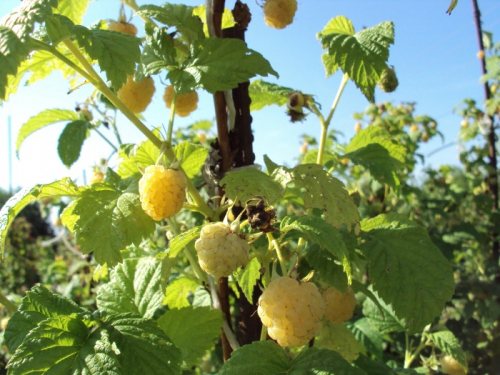

In spring, the bushes quickly awaken from winter dormancy, and already in May - early June they begin to bloom actively. The size of their flowers is not too large, up to one centimeter in diameter, the color of the petals is white, and the stamens are dark. Plants during this period exude a faint honey aroma. A month later, in July, ripe berries appear, while ripening occurs quite amicably, and therefore tedious multiple harvests will not be required. The berries are easily separated from the fruit, which also facilitates harvesting, but the tendency to self-shedding was not noticed for our heroine. The gross harvest from each bush, subject to good care of it, reaches 2 kilograms, and in production conditions on large areas it ranges from 70-80 centners / ha. These results, of course, cannot be called outstanding, however, taking into account the aesthetic splendor of the fruits, the productivity of the Runaway can be considered very decent.
The collected raspberries are characterized by a rounded-conical shape of berries, their average size and weight reaching 2.5-3 grams, and most importantly - a stunningly appetizing golden apricot color, rarely found among the entire variety of varieties of this culture. At the same time, the drupes are rather large, but not too tightly connected to each other, which is why even a slight mechanical effect is enough for the berries to crumble into pieces.This circumstance requires very careful handling during cleaning. The fruit pulp is also quite tender, juicy, pleasantly refreshing sweet and sour taste, with an intense aroma typical of raspberries. Berries from those plants that are abundantly provided with sunlight during cultivation have high gastronomic parameters. If the bush is planted in the shade, then most likely you will have to be content with the mediocre, watery and insipid taste of its fruits. On average, their sugar content is about 7-7.5%, titratable acidity is 1.5-1.6%, and the content of vitamin C is about 20 mg per 100 g of raspberries. The seeds are small and hardly noticeable when eating. The tasting score shown during the state test is 3.5 points.
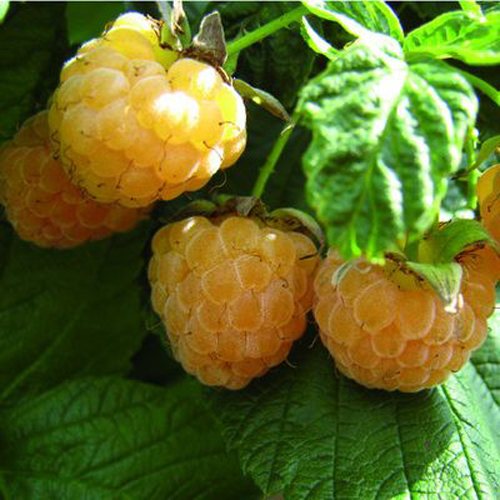

The harvest of the Runaway is used mainly fresh. Due to its pleasant appearance, this variety could be successful in commercial cultivation and sale on the market, however, low transportability indicators discourage farmers from it, whose main goal is to obtain a berry that can be transported over long distances without losing its presentation. So our heroine gets the lot of cultivation at an amateur level, in which suitability for transportation goes into the background, and the taste, aroma and attractiveness of the fruit come to the fore. Surplus crops are successfully processed here into aromatic compotes, juices and fruit drinks, rich in vitamins and microelements.
In the process of cultivation, the variety shows quite decent unpretentiousness and the ability to withstand unfavorable environmental factors. First of all, it should be noted its high frost resistance, which allows it to endure winters without damage in fairly northern regions of our country. In the most severe conditions, bending the shoots to the ground can additionally help, so that they are covered with a snow blanket. Heat and drought resistance of Beglyanka is at the standard level, which allows the bushes to tolerate short periods of moisture deficiency in the soil and high air temperature without any special consequences. Plants are also undemanding to a high level of fertility, as well as to a special mechanical composition of the soil. All this in combination allows our heroine to demonstrate a high level of plasticity and the ability to adapt to a wide variety of cultivation conditions. It shows mixed resistance to pests and diseases. In particular, plants have sufficient resistance to fungal diseases, but they are susceptible to spider mites and mycoplasma overgrowth. Based on this, a strategy for their protection is being built.
How to protect raspberries from pests
In most cases, where raspberries have been growing for more than one year, pests appear. They eat the leaves and fruits, causing the harvest to deteriorate.
- A distinctive feature of the raspberry moth is the light spots on the wings. It is a dark butterfly whose larvae eat the kidneys. After getting into the stems, they turn into pupae there, destroy the fruitfulness of the berries, and for the winter they remain in cracks in the bark. To get rid of pests, it is necessary to treat the culture with karbofos, Iskra or Confidor.
- The spider mite creates a cobweb from the bottom of the leaves, as a result of which the leaves dry. You need to destroy it with similar substances.
- But the raspberry fly leaves its own eggs in the stems and leaf axils and the larvae that appear from them harm young stems. To eliminate this problem, the affected tops are cut off every two weeks. Before flowering, but after harvesting, the culture is treated with the same preparations.
- Finally, the raspberry beetle is an oval gray insect about 4 millimeters long. The larvae of this beetle eat not only leaves, but also berries with stems.You can get rid of this misfortune in only one way: spread films under the bushes and shake them well in the early morning. After the beetles fall, they simply need to be crushed.
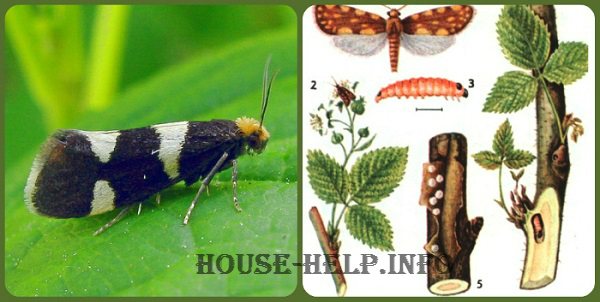

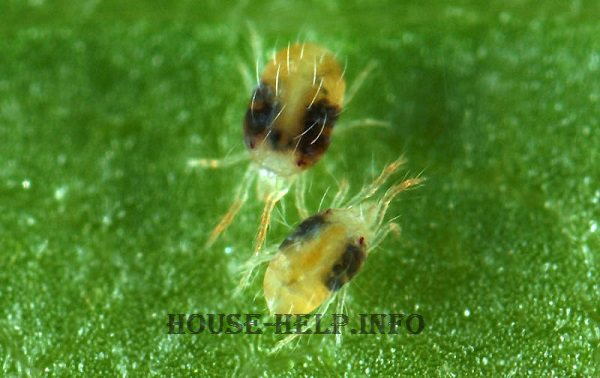

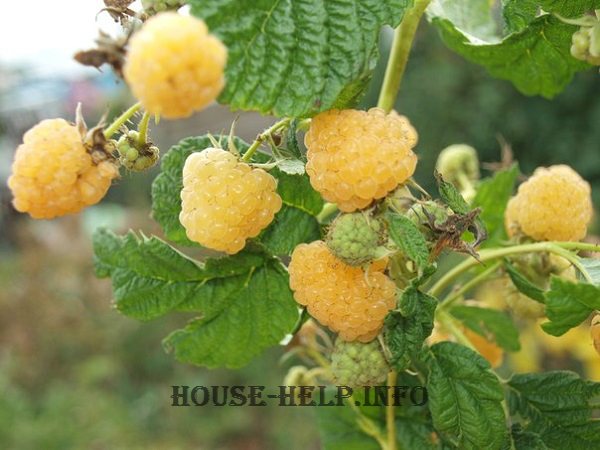

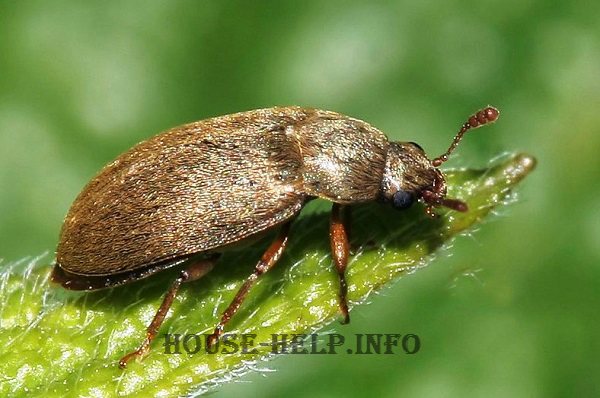

Note! As for other pests, they are smaller, so it is quite difficult to detect them on the stems. They are fought with the same means or others sold in stores. You need to act according to the instructions, but you can use these funds for prevention purposes.
In addition, the affected stems are burned in autumn. The soil under the bushes is dug up so that the insects buried there for the winter would die from frost.
Of course, it is advisable to prevent the appearance of insects than to destroy them in the future. And this, it turns out, is not so difficult.
- Raspberries should be weeded constantly so that the parasites do not have anything to eat and they do not multiply.
- The raspberry must not be allowed to thicken. To do this, every autumn, fertilized stems are removed to improve ventilation between the bushes.
- All trimmings after the procedure should be collected and burned.
- The soil under the yellow raspberries should be periodically loosened by 3 centimeters. This should continue for most of the summer.
- With the onset of autumn, the aisles of all the bushes are carefully dug up.
Agrotechnical measures
They approach the choice of a place for planting raspberries with all responsibility, because mistakes made at this stage will emerge over the next 7-10 years, and can lead to the most serious consequences, up to the death of plants in winter. In particular, be sure to make sure that the site is protected from strong winds blowing snow from it in the cold season, and thereby contributing to freezing of the bushes. In addition, you should pay attention to the terrain. If we are talking about planting on slopes, then their exposure should be assessed in terms of moisture and heat supply. In arid and sultry regions, the northern directions of the slopes are better suited for cultivation, and vice versa - in humid and cool conditions, warmer exposures are chosen.
Planting is carried out in early spring or autumn, after the foliage has fallen, in pre-prepared pits, abundantly filled with mineral and organic fertilizers. The layout can be bunch or tape. In the first case, a distance of 50-70 cm is left between the plants, and in the second 30-40 cm.In both options, the row spacing is 1.6-1.8 m.
The vegetative raspberries are taken care of according to the technology worked out for traditional non-repaired varieties. Particular attention should be paid to maintaining cleanliness in the aisles, because the rapid growth of root offspring of the Beglyanka is capable of turning a neat at first raspberry plant into an impassable meadow in a few years.
Care
Let's talk about how to care for yellow raspberries.
Top dressing
In order for your raspberry to please with a high-quality and bountiful harvest, it is necessary to provide careful and proper care for it. It is worth starting with the selection of the necessary feeding.
If you used the trench method of planting raspberries, then you do not need to fertilize the soil. Such a need will appear only a few years after disembarkation. If the seedlings are planted in other ways, then complementary feeding can be carried out:
- nitrogen;
- phosphoric;
- boric or iron fertilizers.
The yield of yellow raspberries is directly related to the force of germination of the shrub immediately after planting. Therefore, such raspberries must be provided with a large amount of nitrogen. Nitrogen fertilizers are applied at the end of winter, around February.
During the first two years, nitrogen baits are placed closer to the bushes, and then they are scattered in a row.
Some gardeners prefer to split the nitrogen fertilizer dosage into two equal parts. The first part is brought in in the fall, and the second closer to the spring. It should be noted that during wintering, most of the fertilizer will be washed off. But at the same time, this will ensure the growth of a large number of shoots, which is a positive point.
Another scheme for introducing feed. In the first year of life of shrubs, nitrogen fertilizers should be introduced in three stages:
- early May;
- mid-May;
- the beginning of June.
Consequently, the time intervals between stages are fourteen days. In the second, third and subsequent years of the plant's life, fertilizers are applied only under raspberries in the spring.
Among nitrogen fertilizers, urea is considered the best. However, it is better to use not a dry version of feeding, but dilute it with water. About one liter of such liquid is added under each bush. Dilution ratio: 50 grams of substance per 10 liters of water.
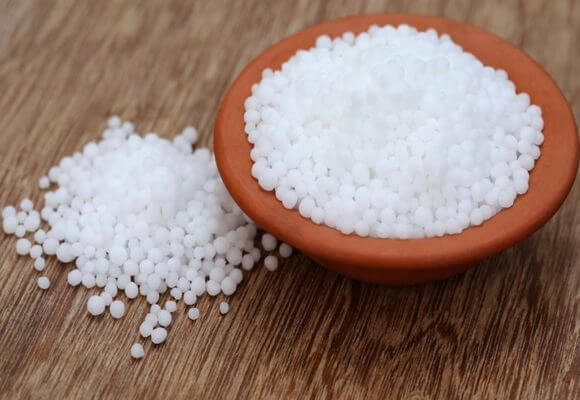

How to determine that raspberries have started their development correctly? Indeed, in some cases, excessive growth begins, and in others, on the contrary, it is inhibited. Correct growth parameters:
- The number of replacement shoots is 12.
- The height of each shoot is 1.5-2 meters.
- The sizes of internodes are 8-10 centimeters.
Other fertilizers are applied if necessary. In order to understand what substances your soil lacks, it is necessary to conduct a laboratory study of the soil and shrubs. If this is not possible, then you can proceed from external data:
- Plant color.
- Foliage quality.
- Sizes of internodes.
- Shoot formation rate.
If you do not use tuka in your garden plot, then add manure under each raspberry bush. This must be done every two years in the fall. The volume of feeding is three kilograms of manure per square meter of raspberries. In addition, ash can be used.
Watering
Watering the raspberries is key to creating a healthy shrub that will yield good and tasty yields in the future. If raspberries grow in the south, then they need to be watered up to eight times during the entire growing season:
- During the active germination of shoots.
- When the ovary is formed.
- After harvesting the fruit.
If we are talking about the northern regions and the middle lane, then four irrigations will be enough:
- During the active growth of shoots.
- After harvesting the fruit.
Watering the raspberry tree occurs through sprinkling or along the grooves.
Garter
Not every variety should be tied up, but if necessary, a row of trellises should be arranged near the raspberry tree. To do this, pegs are driven into the ground, on which a wire is strung in two rows.
The first row is at a distance of one and a half meters from the ground, the second row is at a height of half a meter. Shrubs need to be tied up until the buds open.
Description of Raspberry Runaway
This variety is distinguished by the medium size of the bushes. Shoots are slightly scattered over the site. Note that they are small in Beglyanka and there are up to eight of them per bush. In the second year, the shoots acquire a grayish tint and become erect. Annual plants are light green in color. Runaway stems do not have many thorns. They are green. The spines are short and thin. They, like the plant itself, acquire a gray color with a brown tint in the second year.
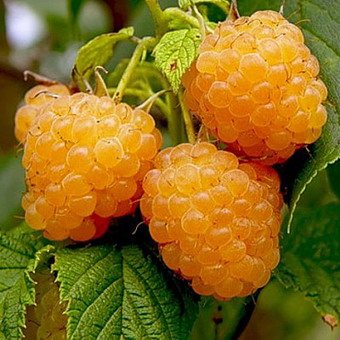

The leaves of this variety are medium in size, slightly wrinkled and green in color. The edge is absent. At the edges, the leaves are slightly serrated with sharp ends.
Gardeners call the fruits of the Runaway "apricots". The berries received this name for a reason, because they have a similar golden color. In shape, the fruit is a rounded cone. The Beglyanka's flesh is tender with a sweet and sour aromatic taste. The weight of a ripe berry reaches three grams.
The Beglyanka variety tolerates cold quite well. The same can be said for heat and drought. These raspberries are resistant to most pathogens and pests. Therefore, it is not surprising that the Runaway is very popular with many gardeners in the country. Subject to all the rules of agricultural technology and acceptable weather, the raspberry harvest will exceed 7.5 tons of berries per hectare.
Gardeners often note the undeniable merits of the Runaway.For example, it is a dietary product. If we compare it with ordinary red raspberries, then in Beglyanka there are much less anthocyanins. That is why allergy sufferers prefer this variety. Another advantage of the yellow berry is the optimal combination of acid and sugar in it. Fans of home cellars also highly appreciate Beglyanka, thanks to which the jam is obtained with an unusual light color.
Fertilizer
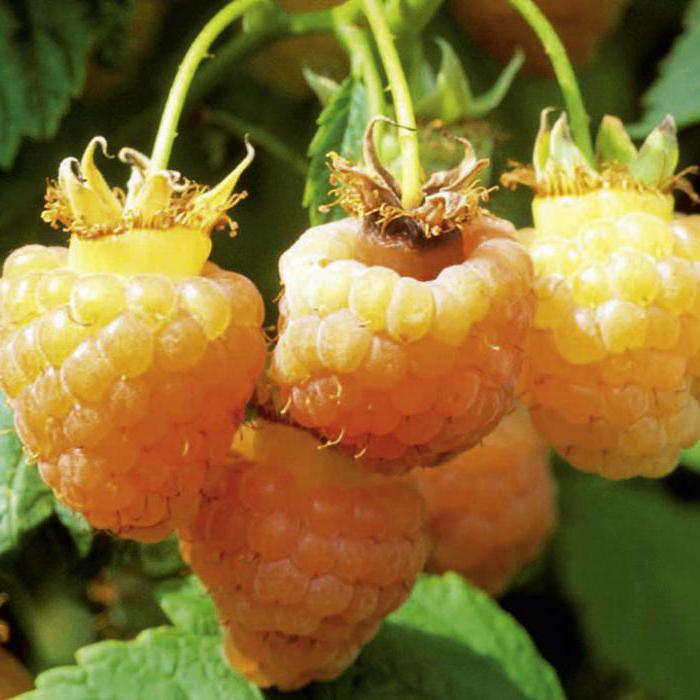

In October, yellow raspberries need organic fertilization in the form of compost or rotted manure. One bucket of fertilizer is required per plant bush. If the autumn is dry, the raspberries are watered abundantly with water (at least three buckets of water under each bush).
Amateur gardeners should remember that for the successful cultivation of yellow raspberries, great importance should be given to mulching the soil under the plantings, as this:
- promotes moisture retention in the root zone;
- inhibits the growth of weeds;
- keeps warm and protects roots from frost.
Yellow raspberries, which are easy to plant and care for, love nitrogen and constantly moist soil. Therefore, the bushes are abundantly watered with infusion of weeds in early June. Weed infusion is well diluted with water in a ratio of 1:10. In order to preserve moisture in the soil for as long as possible and prevent the appearance of weeds, the soil under the raspberries is poured with slurry or thick from under the infusion of weeds.
Landing
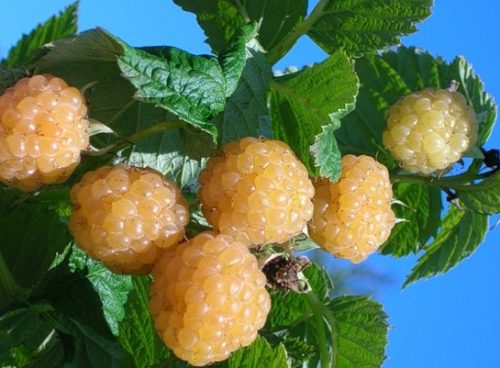

Planting the Runaway, like any other raspberry, is not a big deal. The plant takes root better on slightly acidic or neutral soil. The best place for raspberries is a sunny area, where the wind does not fall, and in winter there is a lot of snow. It is worth noting an important fact that it is better not to plant bushes where tomatoes or potatoes grew before, because these plants have similar diseases.
The fugitive is planted in spring or autumn. It is not recommended to land in the summer, because the plant will not take root trite.
There are two ways to plant raspberries that are appropriate for the seasons mentioned.
Landing in the holes
The holes are dug in the size of 0.5 mx 0.5 m. Raspberry roots are soaked in a solution from a mullein and lowered into the ground, where the planting mixture should be. From above, the hole is covered with fertile soil.
The bushes are planted a meter apart. A two-meter indent is maintained between the rows. Note that when planting in the holes, the root collar must be several centimeters above ground level. After that, you need to water the soil.
Trench planting
With this method of planting, it is necessary to dig a trench half a meter deep and wide. The distance between the rows here is reduced to one meter, between the bushes - to half a meter.
The trench is then filled with planting nutrients. In most cases, it consists of rotted manure and mineral fertilizers. Such a layer at the bottom of the trench should be about 15-20 centimeters. After that, we mix everything with the ground and plant the Runaway.
We water raspberry seedlings. Further, gardeners recommend mulching the ground with humus or peat. However, if the soil is already wet, then purely symbolic watering of holes or trenches can be dispensed with.
It is advisable to plant the Runaway next to calendula or dill. Such a neighborhood will protect the plant from the invasion of unexpected guests - a numerous kind of pests.
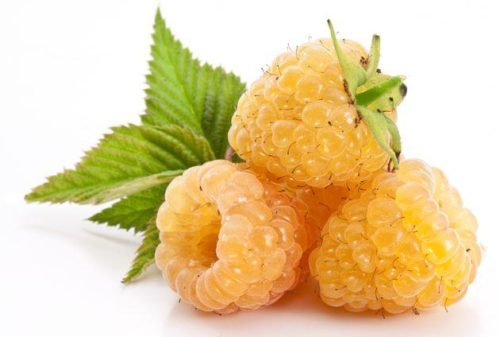

To protect the plant from insects in spring and autumn, the Runaway must be loosened by about a dozen centimeters. In this case, you need to remove the remnants of the bushes, it is advisable to take them outside the site or burn them. To prevent beetles and weevils from attacking raspberries during flowering, the plants must be shaken off from pests on a regular film, which must be spread on the ground near the Runaway. Most of all, this variety is afraid of the raspberry gnat and spider mite. Experts advise sprinkling raspberries before flowering with special karbofosky preparations.They are great help against potential insect infestations. It is better to carry out preventive measures than to ruin all the previous work in the raspberry tree in a few weeks.
Note that spraying must be carried out on a cloudy, windless day. This procedure is done either early in the morning or in the evening, when the sun is no longer so hot.
If you notice wilting of the tops of the bushes, then you need to cut them off and then burn them. Experts advise to carry out such a procedure about twice a month.
Weeding the plant should not be avoided. Raspberries will answer the caring owner with a rich harvest. However, it is worth noting that it is not recommended to touch the soil layer to a depth of more than ten centimeters.
Watering the Runaway is standard, like any other raspberry. It is carried out in furrows, which are adjusted to the characteristics of the site and soil.
Pruning raspberries in the fall
Autumn pruning of yellow raspberries is no different from pruning red. Also, before the cold weather, we cut off the tops of the stalks of the first year of life by 14-16 cm, which will not have time to ripen to frost and will die.
All stems that have borne fruit in the current year, when the last ripe berries are harvested, are cut at the root without regret. By the spring they will dry out anyway and will stick out a mute reproach among the young stems.
After that, we tie the young stalks of raspberries, which have reached the height of an adult plant, into bundles, which we bend to the ground no higher than 29-31 cm and tie them there. In winter, these stems will be covered with snow, and they will winter well.
We must not forget about the autumn watering. This is done shortly before the onset of cold weather. Water each raspberry bush very well. Then they spend the winter better and "wake up" faster in the spring.
Testimonials
Igor S: I love this berry for its unusual apricot color! Because of this, I am even ready to close my eyes for being fastidious in storage.
Kirill M: If you are tired of ordinary red raspberries, then the Runaway is made for you. But right away it is worth considering that you will have to tinker with it more. However, the result is worth all the work spent!
Anna V: Unfortunately, I'm allergic. But thanks to the Runaway I can pamper myself with raspberries.
Egor P: Excellent variety! Just do not forget to feed the plant with organic matter in the spring. Personally, I use cow dung.
Distinctive features of yellow raspberries
The main difference between yellow and red raspberries is a sweeter taste, since this berry contains fewer acids.
Most varieties are remontant and have high yields. The berries grow large from 5 to 12 grams, at least 6 kilograms of yellow raspberries can be harvested from each bush.
There is an opinion that berries are poorly stored and transported, and this is partly true. The old varieties had such a feature, but, thanks to breeders, all modern varieties have a dense drupe and are perfectly stored.

